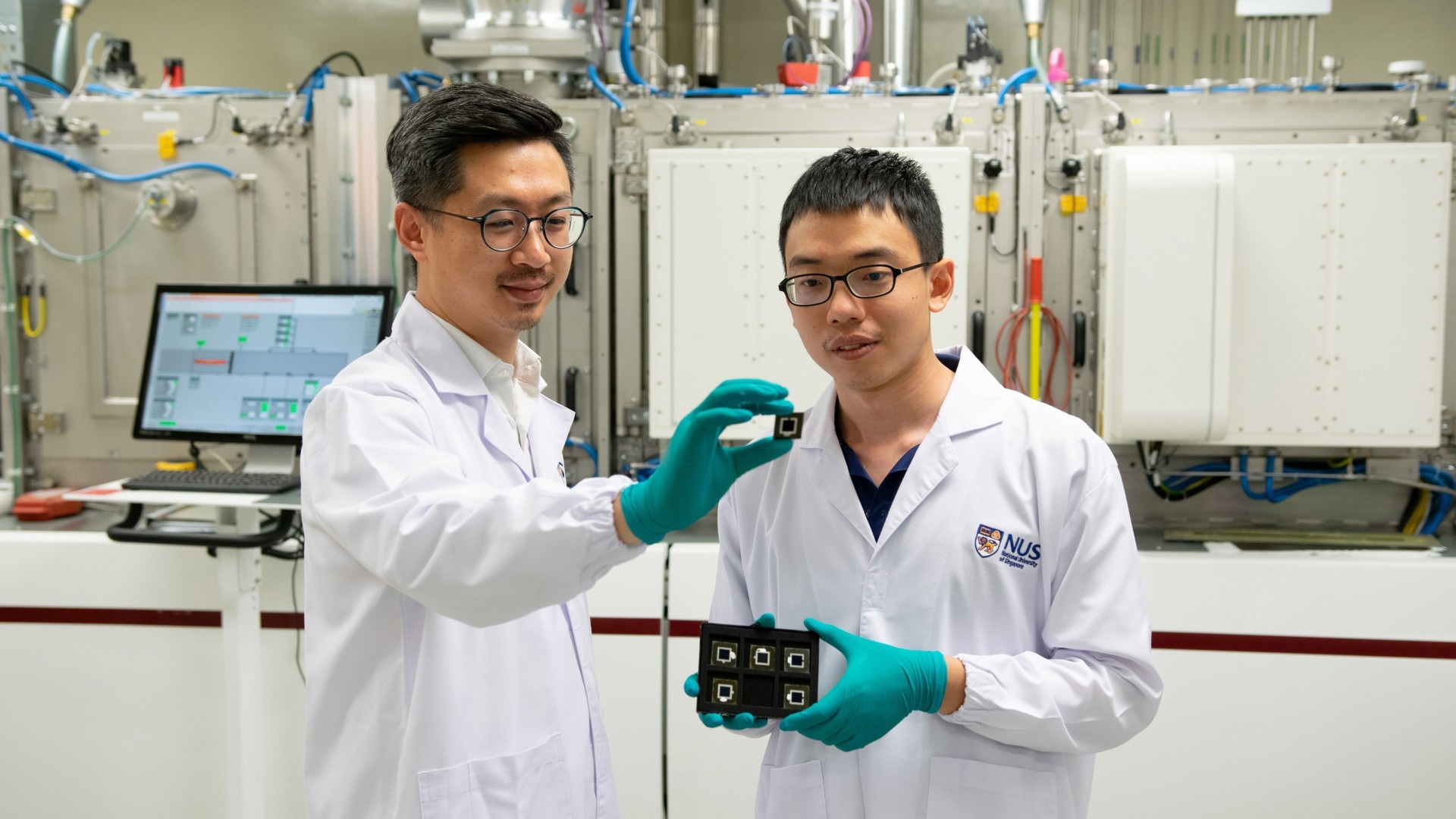A team of researchers from the National University of Singapore (NUS) has constructed a novel triple-junction perovskite/Si tandem solar cell.
 With the potential to achieve more than 50% power conversion efficiency, this new triple-junction perovskite/Si tandem solar cell technology developed by Assistant Professor Hou Yi (left) and Dr. Liu Shunchang (right) paves the way for a wide range of applications to harness solar energy with space constraints. Image Credit: National University of Singapore.
With the potential to achieve more than 50% power conversion efficiency, this new triple-junction perovskite/Si tandem solar cell technology developed by Assistant Professor Hou Yi (left) and Dr. Liu Shunchang (right) paves the way for a wide range of applications to harness solar energy with space constraints. Image Credit: National University of Singapore.
The new solar cell is capable of realizing a certified world-record power conversion efficiency of 27.1 % spanning a 1 sq cm solar energy absorption area, making it the most efficient triple-junction perovskite/Si tandem solar cell to date.
To accomplish this, the researchers designed a new cyanate-integrated perovskite solar cell that is energy-efficient and stable.
Solar cells can be manufactured with multiple layers and assembled into multi-junction solar cells to enhance efficiency. Each layer is composed of distinct photovoltaic materials that absorb solar energy across a diverse range. However, existing multi-junction solar cell technologies face many challenges, including energy loss, which results in operational instability and low voltage.
To address these challenges, Assistant Professor Hou Yi along with a team of researchers from the NUS College of Design and Engineering (CDE) and the Solar Energy Research Institute of Singapore (SERIS), pioneered the integration of cyanate into a perovskite solar cell. This innovation led to the development of a state-of-the-art triple-junction perovskite/Si tandem solar cell capable of outperforming other comparable multi-junction solar cells in terms of performance.
Assistant Professor Hou holds the position of Presidential Young Professor at the Department of Chemical and Biomolecular Engineering within the NUS CDE. Additionally, he serves as a Group Leader at SERIS, which is a university-level research institute in NUS.
Remarkably, after 15 years of ongoing research in the field of perovskite-based solar cells, this work constitutes the first experimental evidence for the inclusion of cyanate into perovskites to boost the stability of its structure and improve power conversion efficiency.
Hou Yi, Study Lead Author and Presidential Young Professor, Department of Chemical and Biomolecular Engineering, National University of Singapore
Details of the experimental process that resulted in this revolutionary discovery have been published in the March 4th, 2024 issue of Nature.
Fabricating Energy-Efficient Solar Cell Technology
The energy range that a perovskite structure can reach is determined by the interactions between its components. Modifying the proportion of these components or identifying suitable substitutes can alter the energy range of the perovskite. However, previous studies have not succeeded in creating a perovskite formula with both high efficiency and an ultrawide energy range.
In their recent study, the NUS researchers explored the use of cyanate, a novel pseudohalide, as a replacement for bromide, a common halide ion used in perovskites. Dr. Liu Shunchang, a Research Fellow in Assistant Professor Hou Yi’s team, utilized several analytical techniques to verify the effective integration of cyanate into the perovskite structure. Dr. Liu then fabricated a perovskite solar cell incorporating cyanate.
Additional analysis of the atomic structure of the new perovskite provided experimental evidence, for the first time, that the integration of cyanate helped stabilize its structure and form crucial interactions inside the perovskite. This finding shows the cyanate’s viability as a substitute for halides in solar cells with perovskite.
During the performance assessment, the NUS team discovered that perovskite solar cells integrated with cyanate could realize a higher voltage of 1.422 volts than conventional perovskite solar cells (1.357 volts), as well as delivering a significant decrease in energy loss.
The scientists also conducted a test on the newly engineered perovskite solar cell by constantly operating it at full power for 300 hours under regulated conditions. At the end of the test period, the solar cell continued to be stable and performed above 96% capacity.
Stimulated by the remarkable performance of the cyanate-incorporated perovskite solar cells, the NUS researchers advanced their pioneering discovery by incorporating it into a triple-junction perovskite/Si tandem solar cell. The team stacked a perovskite solar cell and a silicon solar cell to form a dual-junction half-cell, which served as a perfect base for attaching the cyanate-integrated perovskite solar cell.
After assembly, the team showed that despite the intricacy of the triple-junction perovskite/Si tandem solar cell structure, it maintained stability and achieved a certified world-record efficiency of 27.1% from an accredited autonomous photovoltaic calibration lab.
Hou Yi noted, “Collectively, these advancements offer ground-breaking insights into mitigating energy loss in perovskite solar cells and set a new course for the further development of perovskite-based triple junction solar technology.”
Next Steps
The theoretical efficacy of triple-junction perovskite/Si tandem solar cells surpasses 50%, indicating substantial potential for additional enhancements, particularly in applications where space for installation is narrow.
In the future, the NUS researchers aim to scale up this technology to bigger modules while maintaining stability and efficiency. Future research will concentrate on advances in the interfaces and composition of perovskite, which the team has identified as important areas for further advancing this technology.
Journal Reference:
Liu, S., et al. (2024) Triple-junction solar cells with cyanate in ultrawide bandgap perovskites. Nature. doi:10.1038/s41586-024-07226-1.